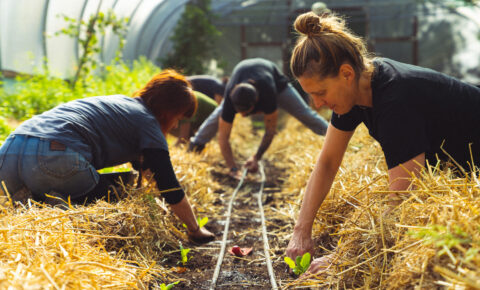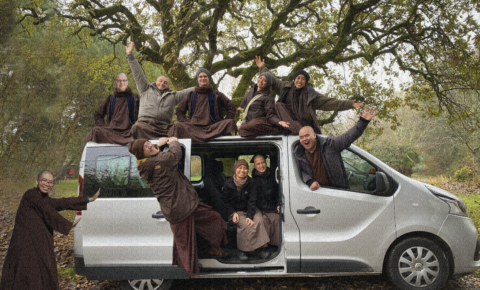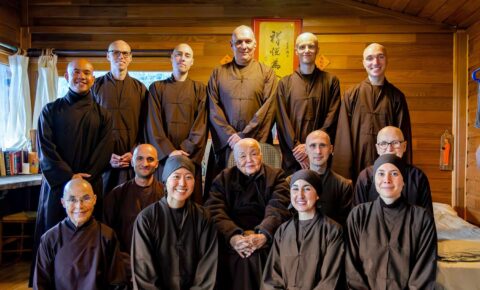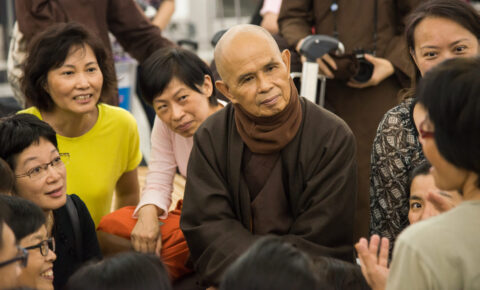Renewing Buddhism in Asia
Our practice at Plum Village has contributed a great deal not only to Buddhism in Europe and the United States, but also to Buddhism in Vietnam and other areas of Asia. Without monastic disciples, I would not have been able to write Stepping into Freedom, our hand-book sharing practical guidance and requirements for novices. The book that is currently used by novices in Buddhist countries was written over four hundred years ago. I felt it was outdated and no longer appropriate. I sate with my disciples to compose thirty-nine chapters on mindful manners, instead of the original twenty-four.
This new handbook includes such areas of practice as how to use a computer in mindfulness and how to facilitate discussion about the Dharma. The Ten Mindfulness Training is also presented here in a complete, practical, and beautiful way.
Without the monastic Sangha, we would not have been able to offer to Vietnam the daily chanting book, written in modern Vietnamese, which many temples are now using. (Most traditional chanting books in Vietnam are written in Sino-Vietnamese, which many people do not understand.) We have been able to write and publish many reference books that temples, meditation center, and Buddhist Universities in Vietnam and other countries in Asia find beneficial. For example, the Heart of the Buddha’s teachings, a book on basic Buddhism as taught to monks and nuns, is now used as course material in Buddhist institutes in Vietnam.
We created a four-year training program for monks and nuns, helping monastic become capable of organizing retreats and leading day of mindfulness. After five years, monastic can be considered to receive the transmission of the Dharma Lamp to become Dharma teachers: monastic, lay, and honorary monastic dharma teachers. About eighty monastic and fifty laypeople have received the Dharma Lamp and led retreats all over the world. There are also numerous honorary monastic Dharma teachers who are teaching in Vietnam.
A Meeting of East and West
The difficulties we encountered in establishing Plum Village were the problems the Buddha also had, but there were new difficulties too. One difficulty the Buddha had a little of (and we have had a lot of) is differences between cultures. Our Sangha is made of twenty or more nations and cultures. This is not a Vietnamese temple set up in Europe. It has root in Vietnam, but it has to grow and be appropriate for the environment where it is growing. When we bring plants from Vietnam and plant them in the West, they do not grow mustard greens in France, they grow thorns. That would never happen in Vietnam. We have to know how to adapt to our surroundings, and we have to know how to absorb the beautiful things from the cultures. Sometimes, people from both the East and West come to Plum Village and find forms of practice that are not suitable for them, because they carry expectations that it will be like their respective cultures. But in Plum Village is a combination of East and West. When a person from Asia hangs clothes out to dry, they hang the trousers lower than the shirts, and the two legs have to be hung close together. It would be strange for an Asian person to see them hung any other way. An Eastern person can never accept feeding a cat out of a person’s bowl. The bowl the cat eats out of should be different from what humans eat out of. When a Western nun cooks, putting all her heart into cooking, a Vietnamese nun may look at the food and go somewhere else to eat instant noodles. This makes the Western nun very unhappy. This happens everyday in Plum Village. So the cultural gap brings difficulties. It is not any one’s fault. It is just our differences.
In the Buddhist religion in Vietnam there are many jewels. But if we want to offer them, we have to have them within ourselves first. We have to put our roots down in our own tradition very deeply—our educational, ethical, cultural, and our spiritual traditions—to be able to share them. We have to keep the most beautiful things in our culture to be able to offer them to others.
Sharing the practice, we have to learn to understand the culture and the environment of the West. We have to present our own jewels in the way that is appropriate to the western way of thinking. If we don’t understand anything about the language or the behavior of the Western people, how can we offer anything? There are teachers from the East who have jewels from their own cultures, but they have not understood Western culture; so there is no way they can transmit these jewels to Western people. You have to understand Western culture before you can share the jewels of your own tradition. In these last thirty-five years, I have learned so much about this.
I have also learned from the East. In the light of Western culture, I have seen the beauties of the East in a way I had not recognized before. Before, I was only able to see 70 percent of the beauty of Vietnamese culture. But now, under the light of Western culture, I can see 100 percent of its beauty. When Western friends come to Plum Village, they also must have their roots in their won culture and spirituality. Then they have something to share with us. It is not that they are hungry ghost, wandering around with nothing to offer. If they have put down their roots in the Western culture, they will have something to offer to us. Because we are open, we can receive from them and both sides will profit. The basic condition to have successful exchange between different cultures is for each person to have his or her roots firmly established. This process takes places year to year, and Plum Village is still learning these things.






Join the conversation